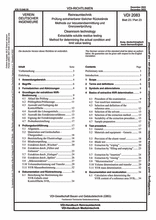Standards Worldwide
Standards Worldwide
Phone +49 30 58885700-07

Technical rule [CURRENT]
VDI 2083 Blatt 23:2022-12
Cleanroom technology - Extractable soluble residue testing - Method for determining the actual condition and limit value testing
- German title
- Reinraumtechnik - Prüfung extrahierbarer löslicher Rückstände - Methode zur Istzustandsermittlung und Grenzwertprüfung
- Publication date
- 2022-12
- Original language
- German, English
- Pages
- 45
- Publication date
- 2022-12
- Original language
- German, English
- Pages
- 45
Product information on this site:
Quick delivery via download or delivery service
Buy securely with a credit card or pay upon receipt of invoice
All transactions are encrypted
Short description
The cleanliness of component surfaces is one of the most important quality characteristics in almost all industries today. Not only particle residues can pose risks to quality, function and safety, but also non-particulate adhesions, e. g. oils, greases, cooling lubricants, residues of corrosion protection agents and preservatives, release agents, fingerprints. This standard describes a method for the quantitative determination of the mass of soluble chemical substances on surfaces by dissolving them with the smallest possible quantity of solvent (minimum quantity extraction) and subsequent weighing of the residue present after the volatilisation of a small partial quantity of the extraction liquid. In this way, the occurrence of soluble residues on components or surfaces can be determined, monitored and communicated as a simple total value. Due to the simple application and fast feasibility, the method is particularly suitable as a uniform basis for formulating limit values for soluble surface coatings in the customer-supplier relationship and for defining and checking the purity status to this end. The standard is aimed at the automotive, household appliance, solar technology, optics, pharmaceutical, medical technology and semiconductor industries, general mechanical engineering, aerospace, process technology, metrology engineers and service providers.
Content
ICS
13.040.35
Also available in
Loading recommended items...
Loading recommended items...
Loading recommended items...
Loading recommended items...
